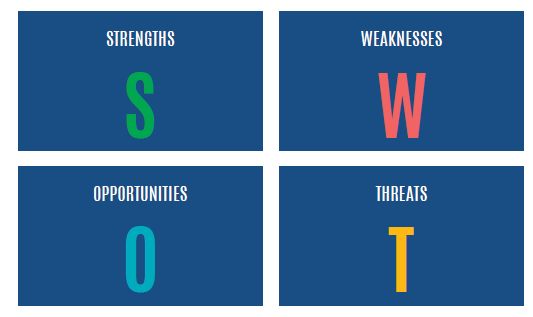6 steps of monitoring the competition
Today’s clients are more aware of existing market offers than ever, which often means that it is they - not salespeople - who know more about what’s on the market. In such circumstances, monitoring the competition becomes one of the most important activities necessary to build an attractive offer.
Dostępny jest przetłumaczony materiał kliknij tutaj, aby przejść do materiału.

Though our day-to-day responsibilities mean we rarely manage to find time for such strategic activities, it’s difficult to think of activities more useful for building long-term client relationships. I’m not worried about someone who offers a 5% lower price. I’m concerned about someone who can offer a better customer experience - the words of Jeff Bezos, the founder of Amazon, perfectly illustrate the point of monitoring the competition, and thus being up to speed with what advantages other companies offer to gain the attention, recognition, and loyalty of potential customers. What are the other reasons why monitoring the competition is important?
Keep your friends close, keep the competition closer
Monitoring the competition gives us first and foremost a point of reference. Looking more broadly - beyond our own activities - gives us the opportunity to compare and identify areas for improvement. This type of self-reflection, including recognising both good and bad behaviour, can be an element supporting not only skills development, but also a customer-oriented attitude. Monitoring the competition also gives us a chance to verify other companies’ good practices, and at the same time note the differences between their offer and ours. Such knowledge helps us build a competitive advantage, particularly when we offer a similar product at a similar price.
However, taking into account customer experience management, competition monitoring activities can be an excellent opportunity to “walk in the customer’s shoes” and thus draw conclusions that can contribute to both improving the sales process, reducing customer effort, and building loyalty.
6 steps to monitoring the competition
Properly organising our competition monitoring activities will help us correctly implement this process and give us confidence in drawing conclusions and implementing changes for further activities. Where should we start?
Step 1: Figure out who to follow
The first step is to identify the companies we should monitor. It’s best if they are the companies with which we directly compete (on a local scale), as well as those who are the market leaders (on a global scale). We can define the first group by performing a basic online search for companies operating in our city or region, and using our own experience, remembering which competitors’ offers our customers most often mention. We can identify the global market leaders using sources such as:
- industry rankings, comparing the leaders in a given sector,
- media (press, television, and online publications) in which our competitors serve as industry experts,
- internet forums and consumer discussion groups where products and services are recommended
- online search engines that provide information on which competitor is best positioned and who gets the best user reviews.
Step 2: Determine what you want to know
Before we start monitoring, we need to determine the scope of information we want to obtain. When carrying out such analysis from a broad perspective, it’s worth considering different issues of business activity (whether a competitor operates locally or nationwide, what products or services they offer, their organisational structure and pricing strategy) as well as promotional and marketing aspects (what advertising, marketing and sales campaigns do they run, what channels do they use to reach potential customers, how are they positioned, how are they assessed by customers, and what are they most appreciated for). From the salesperson’s perspective, it’s worth focusing on elements that provide a reference point, such as:
- product/service range with prices,
- associated services (e.g. financing, insurance, warranty, service, etc.),
- prospecting activities (ways of reaching potential customers),
- how salespeople communicate with customers (how is their customer service, do the salespeople examine customer needs, do they use the language of benefits, do they negotiate and how),
- identifying competitive advantages.
Step 3: Determine which channels you’ll use
We’ll arrive at the most interesting conclusions by monitoring many channels at the same time. Due to the scope of the information we want to obtain, we may use channels such as:
- the competitor’s website and its promotional materials (catalogues, brochures),
- social media channels (Facebook, LinkedIn, Instagram),
- opinion forums and social media reviews, reviews in the company’s Google business card),
- industry rankings,
- media publications (press, internet, television, radio) - both local and national media.
In my opinion, the most beneficial activity in monitoring competition is our own observation. The salesperson should play the role of the customer - calling, emailing or visiting the competition in order to see ‘how they do things’ with their own eyes. This type of experience can prove to be an invaluable source of information, and by participating in such observation, the salesperson will be able to directly refer what happened to his own professional activity.
Step 4: Analyse
To conduct a competition monitoring analysis, it’s worth using a ready-made tool that will guarantee that we’ve collected all the relevant data. This will also be useful to compare the results of observations about various competitors and to prepare a synthesis of results. An example observation sheet is in the Toolbox.
Step 5: Synthesise the conclusions
Conducting competition monitoring activities is only half the road to success. The key in this case is to use the knowledge acquired to implement real changes. Based on the collected data, think about such issues as:
- Which of the competitor’s products/services are in direct competition with your products/services?
- What are the strengths and weaknesses of your competitors?
- What are your competitors’ competitive advantages?
- What are your own strengths and weaknesses?
- What are your own competitive advantages?
The SWOT analysis technique is a simple, useful tool that will facilitate this synthesis. SWOT means identifying Strengths, Weaknesses, Opportunities, and Threats.
Step 6: Create an action plan
With the results of the SWOT analysis, answer two very important questions:
- What can you change in your offer/customer service and sales methods?
- How can you provide your customer with something no one else can give them?
Let this reflection be the starting point for creating an action plan that will bring you to achieving your goal: building an attractive offer for the customer, as well as getting and keeping their loyalty. Also, think about how you’ll use this information in a sales conversation with the client.
How can we use information about the competition in a sales conversation?
Knowledge of the competition is particularly important in two stages:
- recognition - when the customer is just getting to know the market and probably can’t precisely determine what interests them. These customers ask a lot of questions on a general level, aren’t willing to make decisions here and now, or take an ‘I’m just looking’ approach. Salespeople rarely take advantage of the potential of such situations, but in the meantime, this is the perfect moment to emphasise the competitive advantages that will shift the customer’s attention towards our brand;
- decision makingd - when we’re approaching finalisation of the transaction and the customer starts having doubts that naturally lead the customer to compare us with the competition.
In a conversation about the differences between our offer and the customer’s own proposal, we can use the metaphor of the shield and the sword:
- THE SHIELD: awareness of our weaknesses as compared to the competition. These are the areas that we must ‘defend’ against the client.
- THE SWORD: awareness of our strengths as compared to the competition. These are the areas of our strengths, with which we fight for the client.
When preparing for a sales conversation, it’s worth identifying the ‘shields’ and ‘swords’ in our offer so as to be prepared for questions or comments from the customer. Awareness of their existence, as well as the ability to use them in conversation is, however, only one element in building an expert position in our relationships with customers. As a salesperson, it’s also worth:
- having an advantage over the customer - “Of course, you correctly noticed that only models from this series have this system as standard, but did you also know that ...” - customers thoroughly verify the offers of various brands, and know the details, strengths, and weaknesses of their solutions. In order to make a sale in the face of such a challenge, we have to go beyond the customer’s knowledge, to surprise them.
- showing understanding - “I understand your doubt, because our competitors probably propose...” - this approach shows that you understand the customer’s motives and are able to take them into account when creating an offer. By emphasising your knowledge of competitors’ offers, you also build your credibility in the eyes of the customer.
- not speaking badly of the competition - “In endurance testing, our solution worked better than the competition’s model” - use fact-based comparisons to show the advantage of your offer, but don’t speak badly of the competition (e.g. “Their technology is terrible. Customers always complain about...”). This is both unethical and potentially harmful, as the customer may misinterpret your words.
- highlighting advantages you’re sure your competitors don’t have - “We are the only company on the market that provides such security features” - this is particularly important in a situation where your customer hasn’t yet visited the competition. They’ll remember such information, and maybe - if they realise that the competitions’ product really doesn’t offer such advantages - they’ll be more likely to come back to you.















